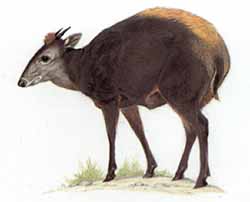English: Yellow-backed Duiker; French: Céphalophe à dos jaune; Azande: Gangono, M’bio; Bila: Moimbo; Duala: Njibo; Ewondo-Beti: Zib; Foulado: Kubeyel; Ful: Ku’beyel; Gbaya: Mbô; Kirundu: igisaho; Lomongo: Lisoko; Manza: Mboko; Peui: Monteval; Punu: Nzibu; Shaba: Ntundu; Teke: Bimba; Wolof: Mbill; Yoruba: gidigidi, Agugugbu.
 |
Former distribution: As now.
Present distribution: From Senegal east to Sierra Leone, southern Mali, northern Guinea, northern Ivory Coast, southern Burkino Faso, central Ghana, Togo, Benin, Liberia, central Nigeria, Cameroon, eastern Gabon, Congo, Zaire, western Uganda, Central African Republic, south-western Sudan, central and southern Kenya, central Zambia, northern Angola.
Behaviour: See Rotflankenducker
Population status: Stable. Rare in Angola, Zambia, Gambia and Uganda.
Brief notes:
Body weight: 60-80 kg
Head and body length: 125-145 cm
Tail length: 15-18 cm
Shoulder height: 70-85 cm
Gestation period: 120 days
Maximum age: 12 years
Trophy: Record SCI: 22 6/8 score, 1978 Sudan, ROBIN A. HURT; average 13 score. RW’s: 8 3/8″, 1958 Tchibota, F. CIVREIS; average 4 1/2″. CIC: 33.00 points, 1976 Zambia, L. CLARK; average 32 points.
Hunting methods: With beaters, dogs, nets, from a hide.
Subspecies: 2.
1. Cephalophus s. sylvicultor Senegal to Zaire, Kenya, Zambia and northern Angola. Rare.
2. Cephalophus s. ituriensis Zaire, Ituri-Forest, western Rwanda. Rare.
Remarks: The validity of these 2 subspecies has to be reconfirmed.






